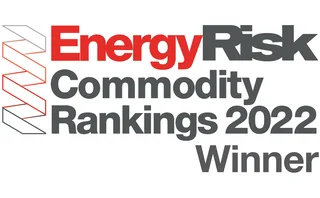
A global solution to market developments


Amid consolidation in the gold market, the UBS precious metals team grew client numbers, expanded into new markets and developed new products and technology, scooping top spots in the 2022 Energy Risk Commodity Rankings
“If I were to describe the gold market in 2021 in one word, it would be ‘consolidation’,” says Andrew Matthews, global head of precious metals distribution at UBS. Unprecedented interest during the peak times of 2020 was driven by a rush to invest in gold as a safe-haven hedge to other asset classes. “As the world emerged on the other side of the [Covid-19] pandemic in 2021, however, and economies started to readjust and recover from the period of lockdowns, it became clear that the stimulus packages created by central banks around the world had resulted in a lot of spare assets and cash. Investors deployed this into equities and fixed income, with quite a significant reallocation out of gold.”
Investors searching for yield started to question the opportunity cost of holding gold, according to Matthews. While there were pockets of volatility for precious metals in the first quarter of 2021 – when retail traders drove the price of silver to an eight-year high of $30 per ounce on February 1, for example – consolidation was the prevailing pattern influencing market activity during the year.
The bank’s ability to manage these market fluctuations was reflected in its positioning in the 2022 Energy Risk Commodity Rankings. In addition to being ranked overall best precious metals dealer by market participants, UBS also continued to dominate all three precious metals categories of gold, silver, and platinum and palladium. The Commodity Rankings are decided by market participants who vote for their top dealers and brokers across a number of major commodities markets.
Developing new technology
UBS used the breathing space afforded by 2021’s market consolidation to further develop its technology offering to its precious metals clients, according to Matthews. “We took this time as an opportunity to explore new initiatives to continually improve and better serve our clients,” he says. In particular, the bank continued to roll out T-Pricer, its options pricing and analytics platform, as well as an algo offering for precious metals clients, which was launched in Q2 2022.
T-Pricer has been key to the bank’s success in the precious metals space over the past year, according to Bimbola Fawehinmi, head of precious metals options trading at UBS. “Most options businesses essentially take a quote from a client and compete on the basis of price, but provide very little support in terms of analytics, for example,” he says. “Our strategy in precious metals has been to support clients throughout the trade, and that’s where T-Pricer comes in. It’s not just about execution, but about what we can do throughout the whole lifecycle of the trade.”

For example, the tool supports clients’ idea generation by suggesting a number of trading strategies to express specific market views and show relevant historical performance data. Fawehinmi says the UBS precious metals team rolled the tool out right across its precious metals client base during 2021. “I believe that has been the biggest contributor – particularly on the derivatives side – to our number one position [precious metals dealer in the rankings],” he adds. “It has helped us to not only maintain the clients and business that we have, but also drive new business.”
The team hopes to replicate such success with its latest tech tools, including offering precious metals clients access to the UBS FX Algo suite. Users will be able to choose from five strategies across currencies including US dollars, euros, Australian dollars and sterling. “There will be a number of benefits for our clients being able to access the full UBS FX algo suite for gold and silver,” Fawehinmi says. “It provides intelligent positioning based on the strategy selected. Clients have wider liquidity access with external sources complementing UBS’s internal matching pool.”
A global offering
Alongside its technology offering, UBS continues to maintain a global team with clearing and custody services in London and Zurich, as well as sales research and trading capabilities in Singapore, London, Zurich and New York. “We have a very experienced team from front to back, which means that, in volatile times, we stand out,” says Matthews. “We pride ourselves on being there for our clients come thick or thin, and providing consistency in service.”
Fawehinmi adds that the bank manages even the most short-term price moves for clients by running a global book. “For us, there really is no difference between time zones,” he says. “We have one book so our traders are very well connected.”
For example, when spot gold prices dropped by 4% in minutes at the start of Asian trading on Monday, August 9, 2021, UBS traders from New York to Singapore worked together to maintain liquidity for clients, according to Fawehinmi. “It’s a global business and that helps us keep our liquidity offering relatively seamless during times like this.”
Supporting physical buyers
The market consolidation of 2021 also prompted UBS’s precious metals franchise – a fully diversified business – to shift its focus to other, more active, market segments. “The pullback in gold prices naturally woke up parts of the physical market and we provided support to those clients – especially into Q4 2021, leading into a seasonally strong uptake in material,” Matthews says.
In addition to increased activity with Chinese buyers of physical gold, UBS also re-entered the Indian market last year. “Having been absent for nearly a decade, we decided to build out our infrastructure in India, which is the second-largest consumer of physical gold in the world,” Matthews adds. “We saw strong activity there in Q4 2021, and that has spilled into this year.”
Another major market segment UBS served last year was the official sector. Central bank purchases rose 82% over 2020 totals to bring global reserves close to a 30-year high, according to the World Gold Council. Matthews says that intensifying UBS’s service in this space during 2021 boosted its central bank and sovereign wealth fund client base. “This community has continued to accumulate gold and increased their purchases as the price of gold remained relatively low,” he continues. “We were there to support the sector in the products they want to trade, and the growth of our network was enabled by collaborating with our colleagues within global markets.”
The new year has brought fresh interest in gold as a safe-haven investment due to geopolitical events and rising inflation fears across global economies, although prices have been somewhat range-bound, capped by a strengthening US dollar and rising bond yields. “We’ve seen long-term investors start to reallocate and ETF [exchange-traded fund] holdings are now well on their way to replacing what was liquidated during 2020,” Matthews says. “If geopolitical risk remains and the risk of inflation holds, we believe that this type of investor will continue to turn to gold.”
By taking the time to further strengthen its offering during the consolidation seen in the gold market in 2021, UBS has been able to grow its precious metals client base. As the latest Energy Risk Commodity Rankings confirm, these clients have benefited from access to deep knowledge of the commodities complex, as well as technology tools, solutions and expertise from across the entire firm.
See the full Energy Risk Commodity Rankings 2022 results
Sponsored content
Copyright Infopro Digital Limited. All rights reserved.
As outlined in our terms and conditions, https://www.infopro-digital.com/terms-and-conditions/subscriptions/ (point 2.4), printing is limited to a single copy.
If you would like to purchase additional rights please email info@risk.net
Copyright Infopro Digital Limited. All rights reserved.
You may share this content using our article tools. As outlined in our terms and conditions, https://www.infopro-digital.com/terms-and-conditions/subscriptions/ (clause 2.4), an Authorised User may only make one copy of the materials for their own personal use. You must also comply with the restrictions in clause 2.5.
If you would like to purchase additional rights please email info@risk.net